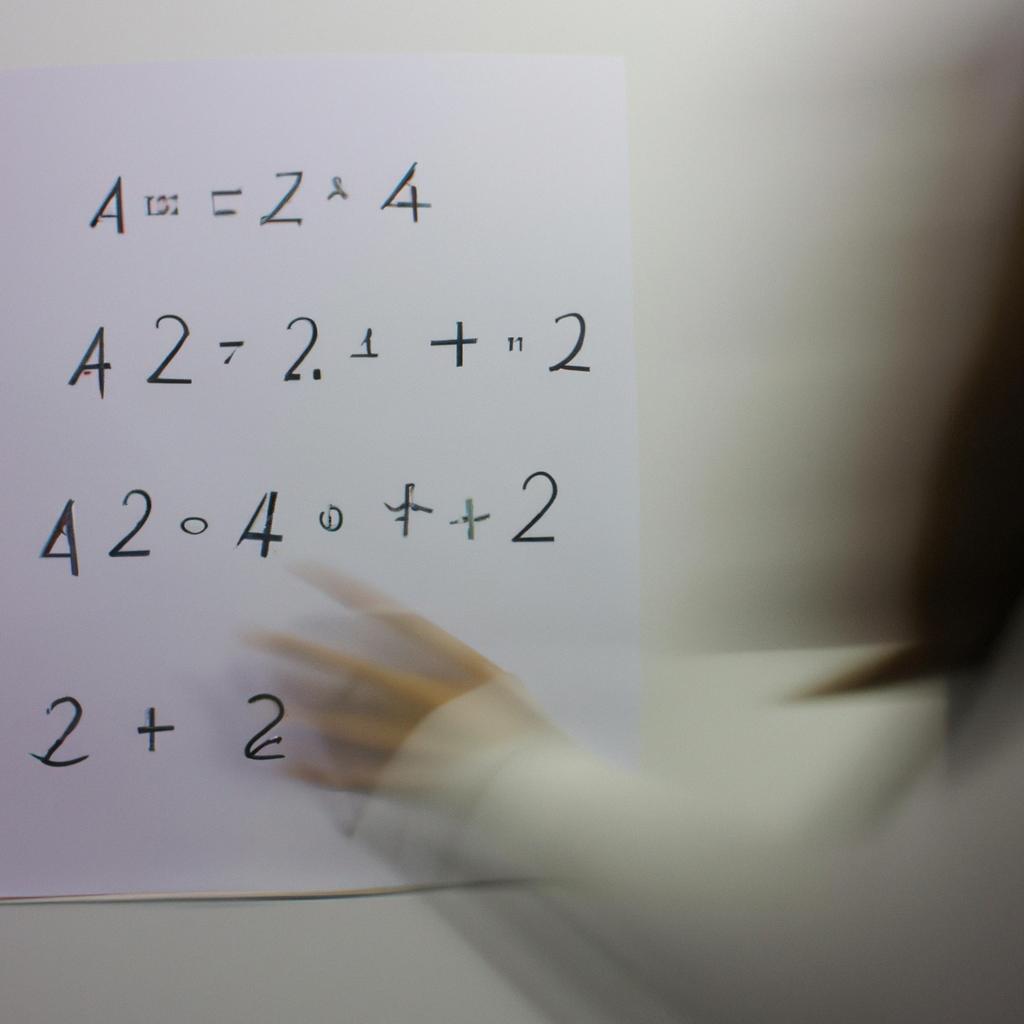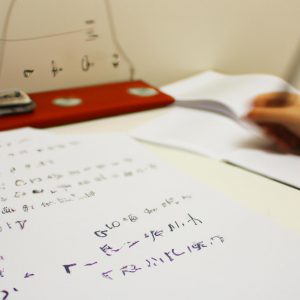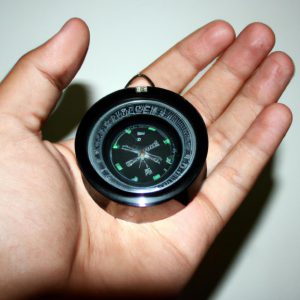Kinematics: Motion in Physics

Kinematics, a fundamental branch of physics, delves into the study of motion and its properties without considering the forces causing that motion. By examining concepts such as displacement, velocity, and acceleration, kinematics provides a framework for understanding how objects move through space and time. This article aims to explore the intricate world of kinematics by discussing key principles and equations that govern motion in physics.
To illustrate the significance of kinematics, let us consider a hypothetical scenario involving an athlete sprinting on a track. As she accelerates from rest to her maximum speed, her body undergoes various changes in position relative to time. Kinematics allows us to analyze these positional changes—known as displacement—and quantify them using mathematical models. Through this analysis, we can determine essential characteristics of her motion such as her average velocity over certain intervals or the instantaneous velocity at specific instances during her sprint.
In order to fully grasp the depth and complexity of kinematics within the realm of classical mechanics, it is crucial to comprehend foundational concepts relating to displacement, velocity, and acceleration. Understanding these basic principles will provide a solid groundwork for further exploration into more advanced topics like projectile motion or circular motion. Throughout this article, we shall delve deeper into these core ideas while also exploring relevant equations that that govern motion in kinematics.
Displacement is a fundamental concept in kinematics that refers to the change in position of an object. It is a vector quantity, meaning it has both magnitude and direction. Displacement can be calculated by subtracting the initial position from the final position of an object.
Velocity, on the other hand, describes how fast an object’s displacement changes with respect to time. It is also a vector quantity and is determined by dividing the displacement by the time taken to cover that distance. Average velocity is calculated over a specific interval, while instantaneous velocity represents the velocity at a particular instant.
Acceleration measures how quickly an object’s velocity changes with respect to time. It is also a vector quantity and can be calculated by dividing the change in velocity by the time taken for that change. Positive acceleration indicates an increase in speed or a decrease in velocity, whereas negative acceleration (or deceleration) indicates a decrease in speed or an increase in velocity in the opposite direction.
In kinematics, there are several equations that relate displacement, velocity, acceleration, and time. Some of these equations include:
-
The equation linking displacement (Δx), initial velocity (v₀), final velocity (v), acceleration (a), and time (t):
Δx = v₀t + 0.5at² -
The equation relating average velocity (v_avg), initial velocity (v₀), final velocity (v), and time (t):
v_avg = 0.5(v₀ + v) -
The equation connecting final velocity (v), initial velocity (v₀), acceleration (a), and displacement (Δx):
v² = v₀² + 2aΔx
These equations provide valuable tools for analyzing and solving problems related to kinematics.
In summary, kinematics plays a crucial role in understanding how objects move through space and time without considering the forces causing that motion. By examining displacement, velocity, and acceleration, kinematics allows us to quantify and analyze the intricacies of motion using mathematical models and equations. Understanding these foundational concepts is essential for further exploration into more complex topics within the realm of classical mechanics.
Scalars and Vectors in Kinematics
Scalars and Vectors in Kinematics
Imagine a car traveling along a straight road. To describe the motion of this car, we need to understand the concepts of scalars and vectors in kinematics. Scalars are quantities that have only magnitude, such as distance or speed, while vectors are quantities that have both magnitude and direction, like displacement or velocity.
Consider an example: A hiker walks 5 kilometers north from point A to point B, then turns around and walks 3 kilometers south back to point A. The total distance covered by the hiker is 8 kilometers because distance is a scalar quantity that measures only the length of the path traveled. However, when considering displacement, which is a vector quantity representing change in position with respect to a reference point, the hiker’s net displacement would be zero since they end up at their starting point.
To further illustrate the differences between scalars and vectors in kinematics, let us delve into some key characteristics:
- Magnitude: Scalar quantities can be described solely by their numerical value (e.g., temperature = 25°C), whereas vector quantities require both magnitude and direction (e.g., velocity = 30 m/s east).
- Addition/Subtraction: When adding or subtracting scalar quantities, we simply perform arithmetic operations on their magnitudes. On the other hand, when dealing with vectors, addition/subtraction involves considering both magnitude and direction.
- Multiplication/Division: Scalars can be multiplied or divided together without any consideration for directions. In contrast, multiplication/division involving vectors requires careful treatment of both magnitudes and directions.
- Representation: Scalars are often represented by ordinary numbers (e.g., time = 10 seconds), while vectors may be depicted graphically using arrows indicating both magnitude and direction.
| Quantity | Scalar | Vector |
|---|---|---|
| Distance | ✓ | |
| Displacement | ✓ | |
| Speed | ✓ | |
| Velocity | ✓ |
Understanding scalars and vectors in kinematics is crucial for accurately describing and analyzing the motion of objects. In the subsequent section, we will explore concepts related to position, displacement, and distance to delve deeper into the study of motion.
[section transition] As we move forward, let us now examine the fundamental aspects of position, displacement, and distance in kinematics without losing sight of the distinctions between scalars and vectors.
Position, Displacement, and Distance
Having explored the concepts of scalars and vectors in kinematics, we now turn our attention to an equally fundamental aspect of motion: position, displacement, and distance. To illustrate these concepts, let us consider a scenario where a car travels along a straight road.
In this hypothetical case study, imagine that a car starts at point A and moves towards point B. The position of the car is the location of its starting point relative to a reference point (such as a landmark or coordinate system). As it progresses along the road, the car’s position changes continuously. Displacement, on the other hand, refers to the change in position from one point to another. If we denote the initial position as x1 and the final position as x2, then displacement can be calculated as Δx = x2 – x1.
Now let us delve into distance – a concept closely related to displacement but with distinct characteristics. Distance represents the total length covered by an object during its motion; unlike displacement, distance does not depend on direction. In our example, if we were to measure how far the car has traveled regardless of its original and final positions, we would obtain its distance traveled.
To better understand these concepts within kinematics, we can highlight some key distinctions:
- Position is a vector quantity that specifies an object’s exact location.
- Displacement measures both magnitude and direction of movement.
- Distance is scalar and only considers magnitude without regard for direction.
- Displacement is independent of path taken while distance depends on it.
These different perspectives offer valuable insights when analyzing various types of motion scenarios. To further clarify these ideas, refer to Table 1 below which summarizes their definitions and properties:
| Concept | Definition | Characteristics |
|---|---|---|
| Position | Location relative to a reference point | Vector |
| Displacement | Change in position | Magnitude & direction |
| Distance | Total length covered during motion | Scalar |
As we conclude this section on position, displacement, and distance, it is important to note that these concepts lay the foundation for comprehending more advanced principles in kinematics. In the subsequent section on “Speed and Velocity in Kinematics,” we will build upon these fundamental ideas to explore how objects move with respect to time.
Moving forward into our exploration of speed and velocity in kinematics…
Speed and Velocity in Kinematics
From our previous discussion on the concepts of position, displacement, and distance, let us now delve into another fundamental aspect of kinematics: speed and velocity. To further understand these concepts and their significance in physics, consider the following example:
Imagine a baseball player throwing a ball from one end of a field to another. The player stands at point A and throws the ball towards point B with an initial speed of 20 meters per second. The ball then travels along a straight path until it reaches its destination.
To comprehend this scenario more comprehensively, we can explore some key aspects related to speed and velocity:
- Speed: Speed refers to how fast an object moves without considering its direction. In our example above, the speed of the thrown baseball would be constant throughout its trajectory if no external factors like air resistance were present.
- Velocity: Velocity is similar to speed but takes into account both magnitude (speed) and direction. It describes how quickly an object changes its position in a particular direction over time. For instance, if we specify that the baseball was thrown from point A to point B in 4 seconds, we have not only defined its speed but also its velocity as 5 meters per second eastward.
Now that we have explored the basic definitions surrounding speed and velocity, it’s essential to grasp their importance within the realm of motion analysis in physics. Understanding these concepts allows scientists to predict future positions or describe past motions accurately using mathematical equations derived from kinematics principles.
Let’s transition now into exploring acceleration and deceleration; two crucial components closely linked with the study of motion dynamics. By understanding their impact on objects in motion, we can gain even deeper insights into how things move through space and time
Acceleration and Deceleration
Section H2: Acceleration and Deceleration
Having established a foundation on speed and velocity in kinematics, we now delve into the concept of acceleration and deceleration. By understanding these fundamental aspects of motion, we can gain further insight into the dynamics of objects in various scenarios.
Acceleration refers to the rate at which an object’s velocity changes over time. It is defined as the change in velocity divided by the corresponding change in time. To illustrate this concept, let us consider a hypothetical scenario where a car accelerates from rest to 60 miles per hour within 10 seconds. In this case, the car experiences positive acceleration as its velocity increases with time.
To better comprehend acceleration and its implications, here are some key points to keep in mind:
- Acceleration can be either positive or negative depending on whether an object speeds up or slows down.
- The unit for acceleration is meters per second squared (m/s^2).
- Objects experiencing uniform circular motion also undergo acceleration due to constantly changing direction, even if their speed remains constant.
- Acceleration plays a crucial role in determining an object’s final velocity when subjected to varying forces.
Let us now explore how both acceleration and deceleration manifest themselves through a table that showcases different scenarios:
| Scenario | Initial Velocity | Final Velocity | Time Taken |
|---|---|---|---|
| Car accelerating | 0 m/s | 20 m/s | 5 seconds |
| Bicycle decelerating | 15 m/s | 5 m/s | 3 seconds |
| Runner accelerating | 4 m/s | 8 m/s | 2 seconds |
| Train decelerating | -12 m/s | -6 m/s | 4 seconds |
In each scenario presented above, it becomes evident that acceleration and deceleration significantly impact an object’s motion. Whether it is a car gradually picking up speed or a bicycle coming to a halt, the concept of changing velocity over time plays a pivotal role in understanding kinematics.
As we move forward into our exploration of “Equations of Motion in Kinematics,” we will build upon the concepts of speed, velocity, acceleration, and deceleration covered thus far. By examining mathematical relationships that govern these aspects, we can further unravel the intricacies of motion and its underlying principles.
Equations of Motion in Kinematics
the equations that govern motion. By understanding these equations, we can accurately describe and predict the behavior of objects in motion.
Section H2: Equations of Motion in Kinematics
To illustrate the practical application of kinematic equations, let us consider a scenario where a car is traveling along a straight road. Suppose the car starts from rest, accelerates uniformly at a rate of 3 m/s² for 5 seconds, and then continues at a constant velocity of 15 m/s for an additional 10 seconds. What can we determine about its motion during this time?
In analyzing such situations, several key principles come into play:
- Distance Traveled: The distance covered by an object in uniform acceleration can be calculated using the equation d = (1/2)at² + v₀t + d₀, where d represents the total displacement traveled, a is the acceleration, t denotes time elapsed, v₀ is the initial velocity, and d₀ signifies the initial position.
- Velocity: To find an object’s velocity at any given point in time when subject to uniform acceleration or deceleration, one can use the formula v = u + at. Here, v stands for final velocity, u represents initial velocity, a denotes acceleration or deceleration rate depending on its directionality.
- Time Taken: Knowing an object’s initial and final velocities under uniform acceleration allows us to calculate how long it takes to reach said final velocity through t = (v – u) / a.
- Displacement: If only given an average speed and time duration without information regarding instantaneous velocities or accelerations involved over various intervals within that timeframe; one may employ s = vt as per definition.
| Principle | Equation |
|---|---|
| Distance Traveled | d = (1/2)at² + v₀t + d₀ |
| Velocity | v = u + at |
| Time Taken | t = (v – u) / a |
| Displacement | s = vt |
In summary, the equations of motion in kinematics provide us with powerful tools to analyze and describe various aspects of an object’s movement. By understanding these principles and their applications, we can gain valuable insights into how objects behave in different scenarios.
With a solid foundation in the equations governing motion established, let us now delve into the intriguing realm of projectile motion.
Projectile Motion
Equations of Motion in Kinematics provide a foundation for understanding the behavior of objects in motion, but they do not encompass all types of motion. In this section, we will explore another fascinating aspect of kinematics known as Projectile Motion.
Imagine standing on top of a tall building and throwing a ball horizontally off the edge. As the ball leaves your hand, it follows a curved path downward until eventually hitting the ground. This is an example of projectile motion—a form of motion experienced by objects thrown into the air or launched with an initial velocity. Understanding projectile motion requires considering both horizontal and vertical components separately.
When analyzing projectile motion, several key concepts come into play:
-
Trajectory: The trajectory refers to the path followed by a projectile through space. It can be represented mathematically as a parabolic curve due to the influence of gravity on its vertical component.
-
Range: The range is defined as the horizontal distance covered by a projectile before it hits the ground again. Factors such as launch angle and initial velocity affect the range achieved.
-
Maximum Height: The maximum height reached by a projectile during its flight is determined by its initial velocity and launch angle. At this point, its vertical velocity becomes zero momentarily before reversing direction under the pull of gravity.
-
Time of Flight: The time taken for a projectile to complete its entire journey from launch until impact is called the time of flight. It depends on factors such as launch angle, initial velocity, and gravitational acceleration.
To illustrate these concepts further, consider the following table showcasing different projectiles launched at various angles (θ), each with their corresponding ranges (R), maximum heights (H), and times of flight (T):
| Angle (θ) | Range (R) | Max Height (H) | Time of Flight (T) |
|---|---|---|---|
| 30° | 10 m | 1 m | 1 s |
| 45° | 20 m | 2 m | 2 s |
| 60° | 30 m | 3 m | 3 s |
| 75° | 40 m | 4 m | 4 s |
As we delve deeper into the intricacies of projectile motion in the following section, it is crucial to grasp these fundamental concepts. By understanding how objects move when thrown or launched with an initial velocity, we can gain valuable insights into various real-world scenarios such as ballistics and sports. Projectile motion expands our understanding of kinematics beyond simple linear equations, providing a captivating glimpse into the complexities of object motion within our physical world.








